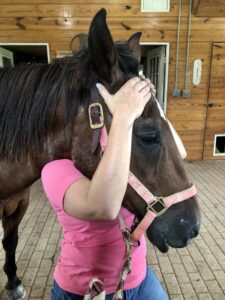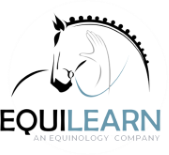
EQ1210: Equine CranioSacral Therapy – Level 2
Date:
Location:
Cost:
Duration:
This course is designed for those individuals who have already participated in the EQ1200: Equine CranioSacral Techniques – Level 1 class, though the two courses are very different. In Level 2, CranioSacral techniques will be expanded and additional exercises to address the body’s dysfunction will be presented. There will be loads of problem solving with various labs and many discussions.
**PLEASE NOTE – Level 1 and Level 2 are NOT designed to be taken immediately back-to-back. The student needs time to practice the moves from Level 1 in order to benefit from Level 2. We recommend at least 5-6 months between the levels.**
After completing the course, the student will be able to:
- Have a better understanding of how the CranioSacral system presents in the horse from a neuromusculoskeletal/fascial standpoint
- Demonstrate the ability to successfully apply advanced CST techniques
- Identify additional CranioSacral system restrictions in conjunction with fascial restrictions and follow the CranioSacral releases throughout the equine body
- Understand when an advanced CST session is appropriate for the horse or when veterinary intervention is recommended prior to commencing CST sessions
- Cite all the contraindications when the advanced CST techniques are not appropriate for the welfare of the horse
- Utilize proper body mechanics to continue working without injury
- Record the session findings in a professional manner utilizing the accepted protocol in the equine health care industry
- Communicate with the other health care professionals as well as the owner and/or trainer in regards to the care of the horse
- Evaluate the overall progress of the horse in response to progressive sessions to determine if the horse is or is not improving with the advanced techniques
Completion of EQ1200: Equine CranioSacral Techniques – Level 1 is required before moving on to Level 2. While Level 1 externships do not have to be completed, the student should be comfortable with the material covered in the Level 1 course.
**PLEASE NOTE – Level 1 and Level 2 are NOT designed to be taken immediately back-to-back. The student needs time to practice the moves from Level 1 in order to benefit from Level 2. We recommend at least 5-6 months between the levels.**
*This course is required for the Equinology® Equine CranioSacral Techniques certification. The EQ1200: Equine CranioSacral Techniques – Level 1 course is also required. In addition, all students wishing to receive their EECST certification must also be certified as an Equinology Equine Body Worker (EEBW) or through a comparable program.
Course Materials (included in tuition):
Course Handouts
Externship (included in tuition):
Externship Grading (Case Studies and Visual Presentation)
Dr. Sandra Howlett, DC. CST-D, ECST, Certified Veterinary Chiropractic, EFLC

Dr. Howlett came into this world with a love of people, animals, and health. She has three passions in life: people helping people, people helping animals, and animals helping people.
Dr. Howlett graduated from Canadian Memorial Chiropractic College in 1987. Her early days in practice were successful, yet she quickly began searching for more education and more diversity. She discovered Dr. John Upledger, DO, OMM and fell into the osteopathic approach, especially cranial osteopathy, in facilitating self-correction. Over the years with Upledger, she became diplomate certified and was an instructor and examiner for Upledger’s students.
Dr. Howlett pursued further training offered under the International Alliance of Healthcare Educators, including neural manipulation, visceral manipulation, lymphatic drainage, and manual brain/glial matrix work. She has also completed the animal chiropractic training, which is a post-doctorate program offered only to veterinarians and chiropractors.
With a further quest for understanding animals, especially horses, Dr. Howlett completed two different certifications in Equine Facilitated Learning/Therapy. When she discovered that addressing “head cases” (including what is often referred to as behavioral) was lacking in the therapeutic approach to helping animals, she developed a curriculum in CranioSacral Therapy. This curriculum is focused on integrating the craniosacral system, the fascial system and the nervous system, thereby facilitating self-healing. This program was originally offered through Integrative Intentions, then Upledger, and now she is pleased to be offering this curriculum through Equinology and its Independent Licensed Companies, including the EquiLearn Institute. She is excited to delve deeper into the science behind the techniques being offered and the overall approach to animal health care.
A $350 deposit is required to hold your spot in a course – the remainder of the tuition is due at least 45 days prior to the course start date. The $350 deposit is nonrefundable and nontransferable, and is credited to the total tuition for the course. Confirmation letters, course outlines, required pre-study (if applicable), directions and lodging options will be sent when the $350 deposit has been received.
This course is designed for those individuals who have already participated in the EQ1200: Equine CranioSacral Techniques – Level 1 class, though the two courses are very different. In Level 2, CranioSacral techniques will be expanded and additional exercises to address the body’s dysfunction will be presented. There will be loads of problem solving with various labs and many discussions.
**PLEASE NOTE – Level 1 and Level 2 are NOT designed to be taken immediately back-to-back. The student needs time to practice the moves from Level 1 in order to benefit from Level 2. We recommend at least 5-6 months between the levels.**
After completing the course, the student will be able to:
- Have a better understanding of how the CranioSacral system presents in the horse from a neuromusculoskeletal/fascial standpoint
- Demonstrate the ability to successfully apply advanced CST techniques
- Identify additional CranioSacral system restrictions in conjunction with fascial restrictions and follow the CranioSacral releases throughout the equine body
- Understand when an advanced CST session is appropriate for the horse or when veterinary intervention is recommended prior to commencing CST sessions
- Cite all the contraindications when the advanced CST techniques are not appropriate for the welfare of the horse
- Utilize proper body mechanics to continue working without injury
- Record the session findings in a professional manner utilizing the accepted protocol in the equine health care industry
- Communicate with the other health care professionals as well as the owner and/or trainer in regards to the care of the horse
- Evaluate the overall progress of the horse in response to progressive sessions to determine if the horse is or is not improving with the advanced techniques
Completion of EQ1200: Equine CranioSacral Techniques – Level 1 is required before moving on to Level 2. While Level 1 externships do not have to be completed, the student should be comfortable with the material covered in the Level 1 course.
**PLEASE NOTE – Level 1 and Level 2 are NOT designed to be taken immediately back-to-back. The student needs time to practice the moves from Level 1 in order to benefit from Level 2. We recommend at least 5-6 months between the levels.**
*This course is required for the Equinology® Equine CranioSacral Techniques certification. The EQ1200: Equine CranioSacral Techniques – Level 1 course is also required. In addition, all students wishing to receive their EECST certification must also be certified as an Equinology Equine Body Worker (EEBW) or through a comparable program.
Course Materials (included in tuition):
Course Handouts
Externship (included in tuition):
Externship Grading (Case Studies and Visual Presentation)
Dr. Sandra Howlett, DC. CST-D, ECST, Certified Veterinary Chiropractic, EFLC

Dr. Howlett came into this world with a love of people, animals, and health. She has three passions in life: people helping people, people helping animals, and animals helping people.
Dr. Howlett graduated from Canadian Memorial Chiropractic College in 1987. Her early days in practice were successful, yet she quickly began searching for more education and more diversity. She discovered Dr. John Upledger, DO, OMM and fell into the osteopathic approach, especially cranial osteopathy, in facilitating self-correction. Over the years with Upledger, she became diplomate certified and was an instructor and examiner for Upledger’s students.
Dr. Howlett pursued further training offered under the International Alliance of Healthcare Educators, including neural manipulation, visceral manipulation, lymphatic drainage, and manual brain/glial matrix work. She has also completed the animal chiropractic training, which is a post-doctorate program offered only to veterinarians and chiropractors.
With a further quest for understanding animals, especially horses, Dr. Howlett completed two different certifications in Equine Facilitated Learning/Therapy. When she discovered that addressing “head cases” (including what is often referred to as behavioral) was lacking in the therapeutic approach to helping animals, she developed a curriculum in CranioSacral Therapy. This curriculum is focused on integrating the craniosacral system, the fascial system and the nervous system, thereby facilitating self-healing. This program was originally offered through Integrative Intentions, then Upledger, and now she is pleased to be offering this curriculum through Equinology and its Independent Licensed Companies, including the EquiLearn Institute. She is excited to delve deeper into the science behind the techniques being offered and the overall approach to animal health care.
A $350 deposit is required to hold your spot in a course – the remainder of the tuition is due at least 45 days prior to the course start date. The $350 deposit is nonrefundable and nontransferable, and is credited to the total tuition for the course. Confirmation letters, course outlines, required pre-study (if applicable), directions and lodging options will be sent when the $350 deposit has been received.
